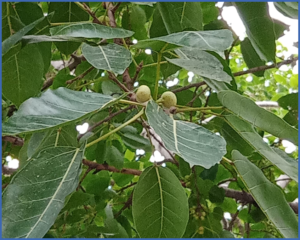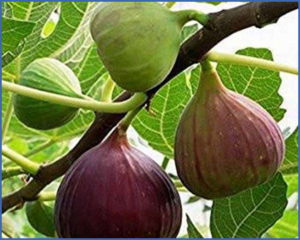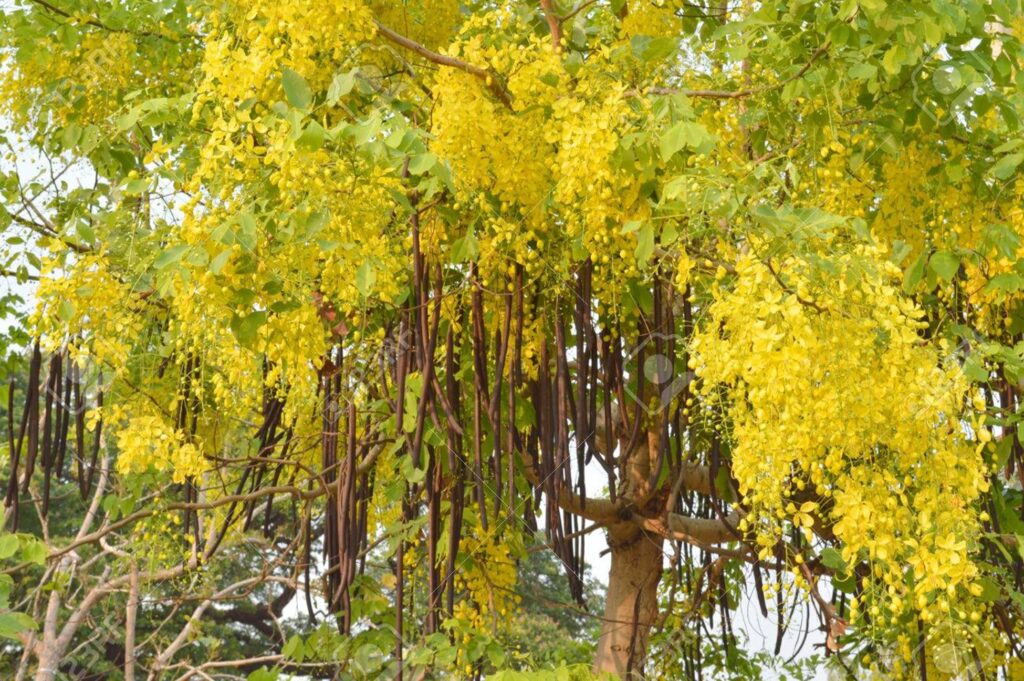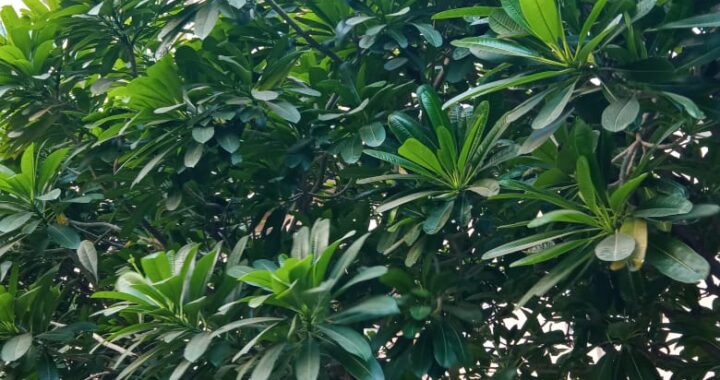For those of us who are botany-challenged, Google Lens has come as a boon.
For us city bred folks, who do not have a background in biology, it is difficult to distinguish a Jacaranda from a Jackfruit tree ! However, Google Lens has given even a layman the power to identify different types of trees.
With mobile in hand, I set out to identify a few trees growing in our residential society in Gurgaon – Ridgewood Estate. As I delved deeper into each tree type, it was fascinating to savor the information that kept coming up.
A word of caution, Google Lens may not give you the correct name in the first shot. You need to keep swiping amongst the options to choose the right option.
Here I describe a few of the many tree types growing in Ridgewood Estate.
- The White Fig
The first tree that I noticed had a weird property, it had roots hanging out of its stem !

Fig 1: White Fig tree growing in Ridgewood
On digging further, Google Lens gave me the following information:
Scientific name: Ficus virens
Common name: White Fig
Hindi: पिलखन Pilkhan, पाखड़ Pakhad, पाकड़ Pakad
The specific quality of the Ficus group of trees is that the roots originate from the stem itself. In the White Fig, the roots commonly wrap around the main stem.

Fig 2: Note the roots growing out of the stem of the White Fig
Since the tree belongs to the genus Ficus, it is related to the common fig tree(Ficus carica) which produces fig fruits. The fruits of the White Fig are much smaller than the common fig, although it is easy to identify the resemblance in shape between the tiny fruits that the White Fig produces, and the actual fig fruit, which is known as अंजीर/anjeer in Hindi.

Fig 3: The White Fig in our residential society produces small fruits

Fig 4: The common fig tree produces much larger fruit, but the shape is nearly identical to the fruits of the White Fig
The White Fig tree is also related to the Bargad (banyan/Ficus benghalensis) & Peepal (sacred fig/Ficus religiosa) trees. All these trees can be identified by the massive aerial roots hanging down from their branches.

Fig 5: The sacred Peepal tree growing in Ridgewood (behind the badminton court)

Fig 6: The majestic Banyan tree
The Peepal tree or Ficus religiosa has great religious value, and is considered sacred by the followers of many Indic religions including Hinduism, Jainism and Buddhism. It is also a member of the Moraceae (fig or mulberry) family. It is also known as the ashvattha tree, bodhi tree, pippala tree or peepal tree. Sadhus (Hindu ascetics) meditate beneath sacred fig trees, and Hindus do pradakshina (circumambulation) around the sacred fig tree as a mark of worship.
On the other hand, Banyan trees have long aerial roots found that grow down from the branches into the ground. The branches are unusually long and the trees can grow and spread great distances. Early European travelers named the tree banyan, as it was observed that the shade of the tree was frequented by Banyas (a corruption of Baniyas, a community of Indian traders) who set up stalls under its shade.
The banyan is India’s national tree, and is referred to as “the Vata-vriksha,” in Sanskrit. Banyans are ecological linchpins. They produce vast crops of figs that sustain many species of birds, fruit bats, primates and other creatures. Banyans are the world’s biggest trees in terms of the area they cover. The biggest Banyan tree alive today is in the Indian state of Andhra Pradesh. It covers 1.9 hectares (4.7 acres) and can shelter 20,000 people.
- Amaltas (The Indian Laburnum)
The next tree that caught my attention had gorgeous golden yellow flowers hanging like garlands.
This tree is the pride of Gurgaon, and in the summer months you can find many lanes lined with this charming tree blooming in all of its golden glory.
It is a common sight in Gurgaon, but I didn’t know its name. It blooms in late spring/early summer in hot, dry weather.
Google Lens enlightened me that the tree is known as:
Scientific name: Cassia fistula
Common name: Golden Shower Tree, Golden rain, Golden chain, Indian Laburnum, Pudding Pipe Tree
Hindi: अमलतास Amaltas; स्वर्णपुष्पी Swarn-pushpi; Bandarlathi
The last name probable refers to the fact that its long pods, were used to shoo away monkeys in the past !

Figure 7: An Amaltas tree growing in our society park

Figure 8: One of the many Amaltas trees found on Gurgaon’s streets
The Cassia Fistula (Amaltas) is both the national tree and the national flower of Thailand and is also the state flower of Kerala. It is used extensively in Ayurveda, as it has many medicinal properties. The Bark of the tree is used in Ayurveda in the treatment of inflammatory swellings and as a cleaning agent for ulcers and wounds. The fruits are also used as a laxative.

Fig 9: Notice the delicate yellow flowers of the Amaltas tree, found in abundance in Delhi NCR

Figure 10: An Amaltas ( Golden Shower tree) in its full glory. Notice the long pipe-like pods which contain its seeds
- The Ashoka tree
The next tree I came across in Ridgewood has a hoary past, and is celebrated in our culture, history & mythology. It is the same Ashoka tree, which finds mention in the Ramayana, as the tree under which Goddess Sita spend her period of captivity in Lanka. This is the place where Hanuman first met Goddess Sita.
It is also believed that Buddha’s birth took place under the Ashok tree. Hence, the Ashok tree is sacred to Buddhists as well, and is seen near Buddhist monasteries.

Fig 11: Leaves of the Ashoka tree
The various names for the tree include
Saraca asoca (Scientific name)
Ashoka (Hindi, Gujarati, Marathi)
Asogam (Tamil)
Oshok (Bengali)
Ashokmu, Vanjulamu (Telugu)
Asokam (Malayalam)
It is an evergreen, comparatively small tree, with branches spreading in all directions, and has a smooth grey-brown bark. The young leaves are copper-red in colour, which change to a deep green shade when they mature. The tree flowers between January-April until June. The flowers are slightly fragrant, and change their colour from yellow/light orange to scarlet red from the inception of buds to wilting. The bright colours of the flowers attract many birds and butterflies.
The word Ashoka literally means “without sorrow”, a reference to it’s bark’s reputation for keeping a woman healthy and youthful. The pulp of the blossoms is used as a remedy for dysentery. Like the Arjuna tree, Ashoka is also used as a heart tonic, as it can help in hypertension & heart problems.

Fig 12: Flowers of the Ashoka tree
- Frangipani (Champa)
The next tree that caught my attention had deep green leaves, with attractive white flowers.
The Frangipani has very fragrant white flowers with yellow centers. The petals are small and strongly overlapping, giving the impression of a flower in the process of unfolding.
Plumeria flowers are highly fragrant and blooms freely from spring throughout fall in multiple colors like white, yellow, pink, and red. However, I was only able to find the white version of flowers in Ridgewood.

Fig 13: Frangipani (Champa) tree growing in Ridgewood
It can be grown both indoors and outdoors. It is a hardy, easy to grow plant requiring minimum care.
Common name: Frangipani,
Scientific name: Plumeria Alba
Hindi: Champa/चम्पा , Golenchi/ गुलैन्च,
Sanskrit: Champaka
Because of their attractive smell, the oil of champa flowers is used in perfumes. The flowers are also used for ornamental purposes during religious or social ceremonies. The flowers are also used for their aroma in hair oils.
You will notice that the flowers give more fragrance at night to attract Sphinx moths for pollination.

Fig 13: The fragrant flowers of the Champa tree. Notice the rounded leaves of the tree
In different parts of India, Champa is utilized as a part of religious offerings. Lord Ganesha is quite found of this flower. These flowers are also offered to Lord Vishnu. However, Champa, is not offered to Lord Shiva as the flower is said to be cursed by him along with the Ketaki flower.
It is said, that the gopis of Vrindavan talked to the champaka trees in the Vrindavana forest while eagerly searching for Krishna, asking them if they had seen their beloved passing by.
Can you identify other trees growing in your society ? If so, do share their names in the Comments below.






we also have 2 or 3 aamla treed ( Indian gooseberry)in our Beautiful Ridgewood estate